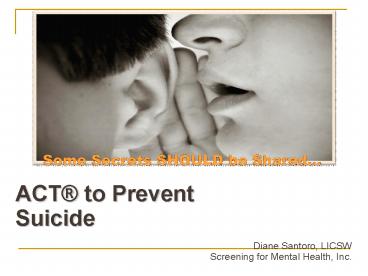Some Secrets SHOULD be Shared PowerPoint PPT Presentation
1 / 14
Title: Some Secrets SHOULD be Shared
1
Some Secrets SHOULD be Shared
- ACT to Prevent
- Suicide
- Diane Santoro, LICSW
- Screening for Mental Health, Inc.
2
Objectives
- Information about the SOS program
- Warning signs of youth depression suicide
- View the SOS DVD
- Importance of working as a team
- What is the school protocol?
- Available resources
3
Why? What? How?
- Why is it important?
- Mortality from suicide increases steadily through
the teens - Children and particularly adolescents who suffer
from depression are at much greater risk of dying
by suicide - What is the SOS program?
- A program to help students recognize the symptoms
of depression or warning signs of suicide in
themselves or others - Teach them the appropriate action steps to take
to get help by using ACT - How are we implementing the program at
Southridge?
4
Depression Youth
- In 2007, 8.2 of adolescents (an estimated 2
million youth aged 12 to 17) experienced at least
one major depressive episode in the past year
(SAMHSA, 2009). - What is a Major Depressive Episode?
- DSM-IV a period of 2 weeks or longer in which
there is either a depressed mood or a loss of
interest or pleasure AND at least 4 of the
following - Increase or decrease in appetite
- Problems with sleeping
- Fatigue or energy loss
- Feelings of worthlessness or excess guilt
- Diminished ability to think or concentrate
5
Prevalence of Suicide Among Youth
- Nationally, suicide is the 3rd leading cause of
death among children ages 15-24 (4,405 deaths in
2006) (CDC, 2004). Only accidents and homicides
occurred more frequently. - Whereas suicides accounted for 1.4 of all
deaths in the U.S. annually, they comprised 12
of all deaths among 15-24-year-olds. - Adolescent suicidal behavior is deemed to be
underreported because many deaths of this type
are classified as unintentional or accidental
(World Medical Association, 2004). - Centers for Disease Control and Prevention,
National Center for Injury Prevention and
Control. Web-based Injury Statistics Query and
Reporting System (WISQARS) online. (2004)
cited 2005 Feb 28. Available from URL
www.cdc.gov/ncipc/wisqars.
6
- In 2007, 8.2 of adolescents (1 in 12 an
estimated 2 million youth aged 12 to 17) reported
experiencing at least one major depressive
episode in the past year (SAMHSA, 2009). - In children and adolescents, an untreated
depressive episode may last between 7 to 9
months, potentially an entire academic year! - More than 90 of people who complete suicide have
a diagnosable mental disorder, most commonly a
depressive disorder or a substance abuse disorder
(NIMH, 2009).
7
By the Numbers
- 2009 Youth Risk Behavior Survey found that
- 26.1 felt so sad or hopeless for 2 weeks that
they stopped doing some usual activity. - 13.8 seriously considered attempting suicide.
- 10.9 made a suicide plan.
- 6.3 attempted suicide.
- 1.9 of those who made an attempt required
medical attention
8
Suicide Risk Factors
- Risk factors are not necessarily causes.
- Suicidal distress can be caused by psychological,
environmental, and social factors. - The first step in preventing suicide is to
identify and understand the risk factors. - The strongest risk factors for suicide in youth
are depression, substance abuse, and previous
attempts (NAMI, 2003). - Mental illness is the leading risk factor for
suicide. - Over 90 of children and adolescents who die by
suicide have a least one major psychiatric
disorder (Gould et al., 2003).
9
Suicide Risk Factors
- Previous suicide attempt(s)
- History of mental disorders, particularly
depression - History of alcohol and substance abuse
- Family history of suicide or child abuse
- Feelings of hopelessness
- Impulsive or aggressive tendencies
- Barriers to accessing mental health treatment
- Loss or interpersonal conflict (problems w/
school or the law - Physical illness
- Easy access to lethal means, especially guns
- Unwillingness to seek help because of the
attached stigma - Local epidemic of suicide
- Isolation
- Incarceration or a pending disciplinary incident
- Exposure to the suicidal behavior of others
- History of physical and/or sexual abuse
- Lesbian, Gay, Bisexual, Transgender youth
10
SUICIDE A MULTI-FACTORIAL EVENT
Psychiatric IllnessCo-morbidity
Neurobiology
Personality Disorder/Traits
Impulsiveness
Substance Use/Abuse
Hopelessness
Severe Medical Illness
Suicide
Family History
Access To Weapons
Psychodynamics/ Psychological Vulnerability
Life Stressors
Suicidal Behavior
11
Warning signs that demand immediate action
- Talking or writing about suicide or death
- Direct verbal cues
- Less direct verbal cues
- Isolation
- Expressing the belief that life is meaningless
- Giving away prized possessions
- A sudden and unexplained improvement in mood
- Neglecting appearance and hygiene
- Dropping out of school or activities
- Obtaining a weapon or another means
12
ACT
- Acknowledge
- Admit you are seeing the signs of depression or
suicide in a friend and it is serious - Care
- Let your friend know that your care about
him/her, and that you are concerned that he/she
needs help you cannot provide - Tell
- Inform a trusted adult, with your friend or on
his/her behalf
13
Myth or Fact
- Its normal for teens to be moody teens dont
suffer from real depression - Teens who claim to be depressed are weak and just
need to pull themselves together. Theres
nothing anyone can do to help - People who talk about suicide wont really do it
- If a person is determined to kill themselves,
nothing is going to stop them - People who commit suicide are people who
unwilling to seek help - Talking about suicide may give someone the idea
14
Questions?
- Related Issues
- Social Networking concerns
- Cutting or Self-harming behaviors

